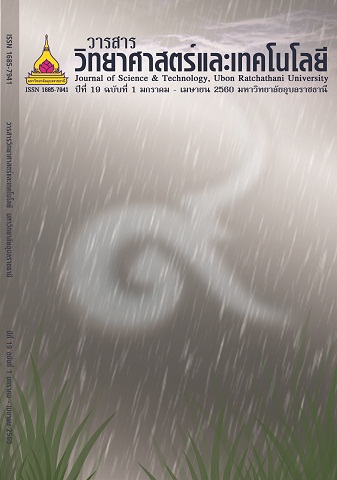การพยากรณ์ความต้องการใช้งานหน่วยจำหน่ายไฟฟ้าด้วย ซัพพอร์ตเวกเตอร์รีเกรสชันแบบตรวจสอบสลับ 3 ส่วน
Main Article Content
บทคัดย่อ
การพยากรณ์ความต้องการใช้ไฟฟ้าได้อย่างแม่นยำ จะทำให้เกิดการวางแผนผลิตกระแสไฟฟ้า ได้อย่างมีประสิทธิภาพ ส่งผลให้ต้นทุนการผลิตกระแสไฟฟ้าลดลง และค่าใช้ไฟฟ้าของผู้บริโภคลดลงได้ ดังนั้น การวิจัยนี้ จึงมีวัตถุประสงค์เพื่อพยากรณ์หน่วยจำหน่ายไฟฟ้า ที่สะท้อนถึงความต้องการใช้ไฟฟ้า ด้วยการสร้างตัวแบบการพยากรณ์จากเทคนิคซัพพอร์ตเวกตอร์รีเกรสชันแบบตรวจสอบสลับ 3 ส่วน (Support Vector Regression: SVR with 3 Folds Cross-Validation) จากนั้น เปรียบเทียบความแม่นยำของการพยากรณ์กับตัวแบบการถดถอยเชิงเส้นแบบพหุ (Multiple Linear Regression: MLR) และตัวแบบ ARIMA ( Autoregressive Integrated Moving Average) ซึ่งข้อมูลที่นำมาวิเคราะห์ มีลักษณะเป็นอนุกรมเวลา โดยเป็นข้อมูลหน่วยจำหน่ายไฟฟ้าของการไฟฟ้านครหลวง (กฟน.) ที่เก็บรวบรวมข้อมูลจากรายงานสถานการณ์การจำหน่ายไฟฟ้าของการไฟฟ้านครหลวง ตั้งแต่เดือนมกราคม ปีพ.ศ. 2553 ถึงเดือนพฤษภาคม ปีพ.ศ. 2558 และข้อมูลที่สนใจ มีขอบเขตเฉพาะจำนวนหน่วยจำหน่ายไฟฟ้าของผู้บริโภคประเภทบ้านอยู่อาศัย โดยนำข้อมูลตั้งแต่เดือนมกราคม ปีพ.ศ. 2553 ถึงเดือนธันวาคม ปีพ.ศ. 2557 ไปสร้างตัวแบบการพยากรณ์ด้วยภาษาอาร์ จากนั้น ใช้ข้อมูลตรวจสอบ ตั้งแต่เดือนมกราคมถึงเดือนพฤษภาคม ปีพ.ศ. 2558 เพื่อเปรียบเทียบความแม่นยำในการพยากรณ์ของตัวแบบทั้ง 3 ด้วยการวัดค่าคลาดเคลื่อน ได้แก่ ค่า Root Mean Square Error (RMSE) และค่า Mean Absolute Percentage Error (MAPE) จากผลการทดลอง พบว่า ตัวแบบ SVR เป็นตัวแบบที่ให้ค่า RMSE และค่า MAPE ต่ำที่สุด ดังนั้น ตัวแบบ SVR เป็นตัวแบบที่เหมาะสมที่สุดสำหรับนำมาใช้พยากรณ์ข้อมูลหน่วยจำหน่ายไฟฟ้าของการไฟฟ้านครหลวงกับผู้บริโภคประเภทบ้านอยู่อาศัย
The Demand Forecasting of Electrical Power Distribution Units by Support Vector Regression with 3 Folds Cross-Validation
The accurate forecasting of electricity usage makes the efficiently planing about generating electricity, will reduce the electricity generating cost, moreover the electricity usage charge of customer will decrease as well. Therefore, this research applied the forecasting of electrical power distribution unit that indicated to the demand of electricity usage by creating the model of Support Vector Regression (SVR) with 3 folds cross-validation and compare the forecasting accuracy with the model of Multiple Linear Regression (MLR) and the model of Autoregressive Integrated Moving Average (ARIMA). The data set in this research is time series data in terms of units of household electricity usage were obtained from the Metropolitan Electricity Authority of Thailand. The data had been collected monthly from January 2010 to May 2015. Forecasting models with different parameters are generated from three techniques using the training data, which are the series from January 2010 to December 2014 and each model is implemented with R language. The remaining data from January 2015 to May 2015 are employed as the validating data. Forecasting performance of each model is measured by the root mean square error (RMSE) and the mean absolute percentage error (MAPE) metrics. When we compare RMSE and MAPE of three models, the experimental result reveals that SVR model has lowest RMSE and MAPE. As a result, we can conclude that SVR model is the most powerful model to forecast this time series data.
Article Details
บทความที่ได้รับการตีพิมพ์เป็นลิขสิทธิ์ของ วารสารวิทยาศาสตร์และเทคโนโลยี มหาวิทยาลัยอุบลราชธานี
ข้อความที่ปรากฏในบทความแต่ละเรื่องในวารสารวิชาการเล่มนี้เป็นความคิดเห็นส่วนตัวของผู้เขียนแต่ละท่านไม่เกี่ยวข้องกับมหาวิทยาลัยอุบลราชธานี และคณาจารย์ท่านอื่นๆในมหาวิทยาลัยฯ แต่อย่างใด ความรับผิดชอบองค์ประกอบทั้งหมดของบทความแต่ละเรื่องเป็นของผู้เขียนแต่ละท่าน หากมีความผิดพลาดใดๆ ผู้เขียนแต่ละท่านจะรับผิดชอบบทความของตนเองแต่ผู้เดียว

